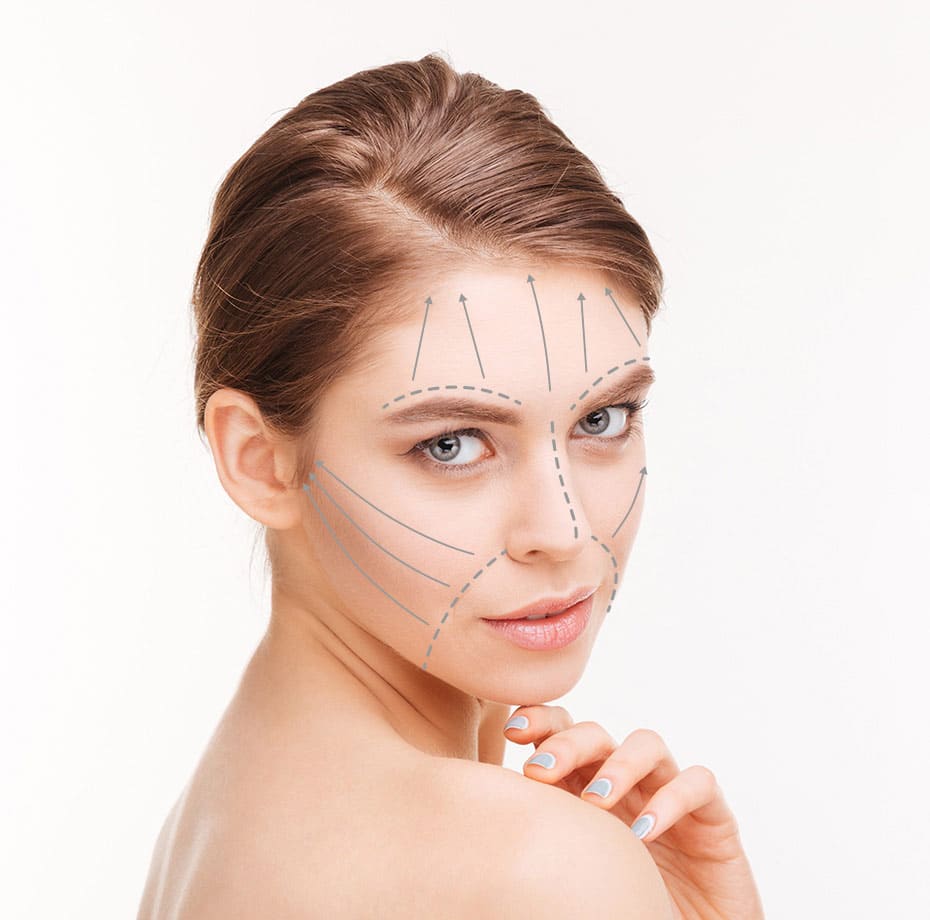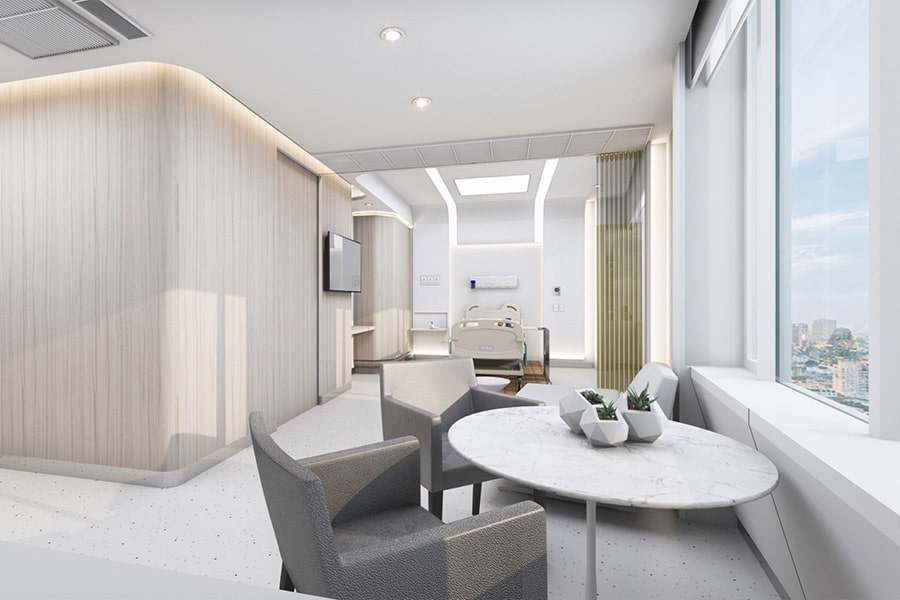
“Say goodbye to sags and wrinkles, say hello to youth and vibrancy”
Face Lift / Rhytidectomy
Face Lift Surgery
Rhytidectomy is a surgical procedure where the face skin is striped in layers in order to lift up the face and replace the fat layers under the skin to their proper locations. Our procedure is deep down to the SMAS (Superficial Musculo Aponeurotic System) layer to improve the lip-cheek groove, Marionette line, and saggy chin areas. After that, the surgeon will remove the excess skin and stitch it around the hairline and the edge of ears which are unnoticeable.
Rhytidectomy can be done according to different face parts, e.g. upper face, middle face, lower face and neck.
Which Areas Can Be Lifted with a Facelift?
Facelift surgery helps tighten and lift the skin to address wrinkles and sagging caused by aging. The most popular facelift procedures today include:
1. Upper Face Lift / Temporal Lift
Targets the temples and outer brows to correct drooping brows that can make the face appear sad or tired.
2. Middle Face Lift
Lifts the area from under the eyes to above the upper lip, tightening sagging cheeks and nasolabial folds for a more youthful look.
3. Lower Face Lift
Focuses on the area below the lips, marionette lines, jawline, and chin to tighten sagging lower cheeks and enhance facial definition.
4. Neck Lift
Addresses loose skin and wrinkles on the neck, making it firmer and smoother.
Each facelift technique is designed to restore a youthful, refreshed appearance by tightening and reshaping specific areas of the face and neck.
If you are experiencing :
Visible sagging, drooping, or folding skin all throughout the face and neck
Dissatisfaction with results from previous procedures’ stitching, Bo, or laser
Visible sagging, drooping, or folding skin all throughout the face and neck
What Type of Skin Sagging is Suitable for a Facelift?
1. Deep Wrinkles and Fine Lines
A facelift is ideal for individuals with deep wrinkles and noticeable fine lines. The procedure helps tighten sagging skin while smoothing out wrinkles, resulting in a smoother and more youthful complexion.
2. Upper Face Sagging and Drooping Brows
A facelift can lift the brows and tighten the upper facial area, correcting droopy brows and restoring a more youthful and refreshed appearance. After the procedure, the brows can be reshaped to achieve a naturally lifted look.
3. Droopy and Sagging Eyelids
If sagging eyelids are covering the natural eyelid crease, a facelift can lift the skin around the eyes, making the eyes appear bigger and brighter while also improving vision by reducing obstruction from sagging skin.
4. Deep Nasolabial Folds, Sagging Cheeks, and Downturned Mouth Corners
A facelift is highly effective for tightening deep nasolabial folds, lifting sagging cheeks, and correcting downturned mouth corners. Since the procedure directly addresses facial sagging, results are visible immediately after the first treatment, making it the best solution for those experiencing these issues.
5. Lower Cheek and Jawline Sagging
A facelift helps firm up the lower cheeks and neck, enhancing the jawline definition and improving facial contours.
6. Neck Sagging
A facelift can also include a neck lift to address concerns such as double chin and loose skin on the neck. A neck lift is an effective solution for those experiencing sagging in the lower face and neck area.
Combining a Facelift with a Neck Lift
A facelift and neck lift can be performed together for a more comprehensive transformation. This approach reduces overall recovery time while ensuring a harmonious and youthful appearance across the entire face and neck
What is Endoscopic Facelift with Endotine?
Endoscopic Facelift with Endotine
is a facelift technique that utilizes an endoscopic approach to enhance precision and visibility of internal facial tissues. This method allows for smaller incisions, minimal swelling, and highly effective results.
What is Endotine?
Endotine is a specialized bio-plastic implant in the form of small, biodegradable anchors that naturally dissolve over time, leaving no residue in the body.
How Does It Work?
Endotine is used to secure the skin and muscles in the forehead area, effectively correcting:
✔ Drooping eyelids
✔ Sagging brows
✔ Deep forehead wrinkles
This advanced technique offers long-lasting, natural results while ensuring a safer and more comfortable facelift experience.
Is a Facelift Surgery Dangerous?
A facelift is a complex surgical procedure that must be performed by a highly skilled and experienced plastic surgeon specializing in facelifts. This is because the face contains numerous delicate muscles and nerves, making the procedure highly intricate and requiring precision to avoid complications.
If performed by an inexperienced surgeon, the risks include:
- Lack of skin tightening leading to ineffective results
- Incorrect facelift technique, which can cause nerve damage
- Facial asymmetry or distortion
- Infections and post-surgical complications
To ensure safety and the best possible results, it is essential to choose a certified specialist and undergo the procedure at a trusted and accredited medical facility with high safety standards.
Who is a Good Candidate for a Facelift?
Facelift surgery is ideal for individuals experiencing sagging skin, wrinkles, and loss of skin firmness, which can make them appear older than their actual age. It is especially suitable for those with:
✔ Deep wrinkles and fine lines on various areas of the face, including the forehead, under-eye bags, and nasolabial folds.
✔ Loose or undefined facial contours, such as sagging cheeks, double chin, or excess fat around the jawline.
✔ Drooping outer corners of the eyes and sagging brows, which can make the face appear tired or aged.
✔ Wrinkled or loose skin on the neck, which can be effectively corrected with a facelift.
A facelift can help lift, tighten, and redefine facial contours for a more youthful, refreshed, and well-balanced appearance.
How Much Does a Facelift Cost and Where is the Best Place to Get One?
With the increasing popularity of facelift surgery, many clinics and cosmetic hospitals now offer the procedure. However, facelift surgery requires the expertise of a board-certified plastic surgeon who specializes in facelifts and has extensive experience in the field.
If you’re wondering where to get a facelift, we highly recommend Wansiri Hospital as a trusted option. At Wansiri Hospital, our highly experienced surgeons specialize in facelift procedures, ensuring safe, precise, and natural-looking results.
Why choose Wansiri Hospital for a facelift?
✔ Expert Surgeons – Specialized in facelift procedures with extensive experience.
✔ State-of-the-Art Operating Rooms – Sterile, high-standard, and fully equipped for safety.
✔ Anesthesiologist Supervision – Continuous monitoring throughout the entire procedure.
✔ Proven Safety & Satisfactory Results – Ensuring a successful and worry-free experience.
Facelift Procedure: Step-by-Step
- Pre-Surgical Assessment
- Before the facelift procedure begins, the surgeon evaluates the patient’s facial condition and level of skin sagging in detail. This assessment helps determine the most suitable facelift technique for the individual.
-
Facial Design & Surgical Planning
- The surgeon designs the facelift approach based on the patient’s expectations and facial structure to achieve the desired results before proceeding with the surgery.
-
Anesthesia & Incision
-
The SMAS and Deep plane layer is lifted and tightened, while excess skin is removed to achieve a more youthful and firm appearance.
- The surgeon then makes precise incisions along the planned areas and carefully dissects through the skin layers to reach the SMAS (Superficial Musculoaponeurotic System) layer and Deep Plane, which is responsible for facial support.
- A board-certified anesthesiologist administers general anesthesia to ensure a pain-free and comfortable experience throughout the procedure.
-
-
Wound Closure & Final Adjustments
- The final step involves meticulous suturing to conceal the scars within the hairline or behind the ear, making them barely noticeable.
- The facelift procedure typically takes 2-4 hours, depending on the extent of the lift and any additional procedures performed in conjunction with the facelift.
Facelift Reviews

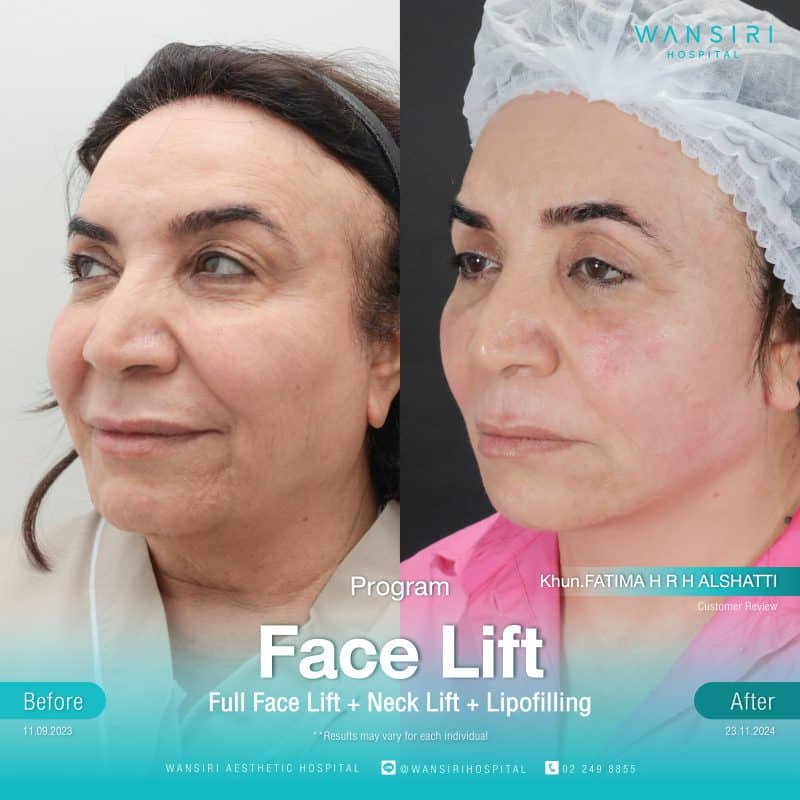
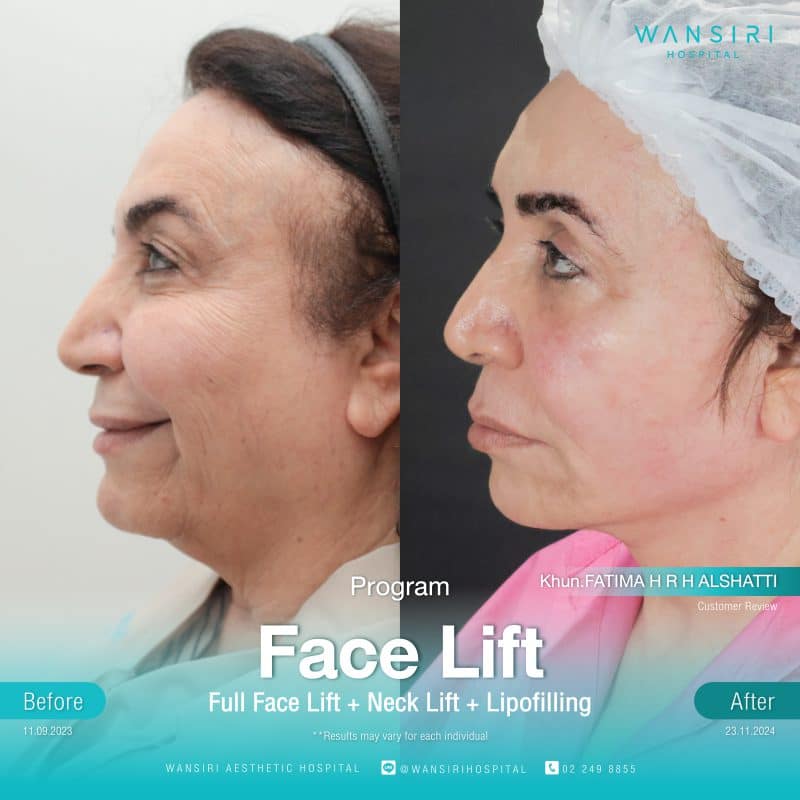
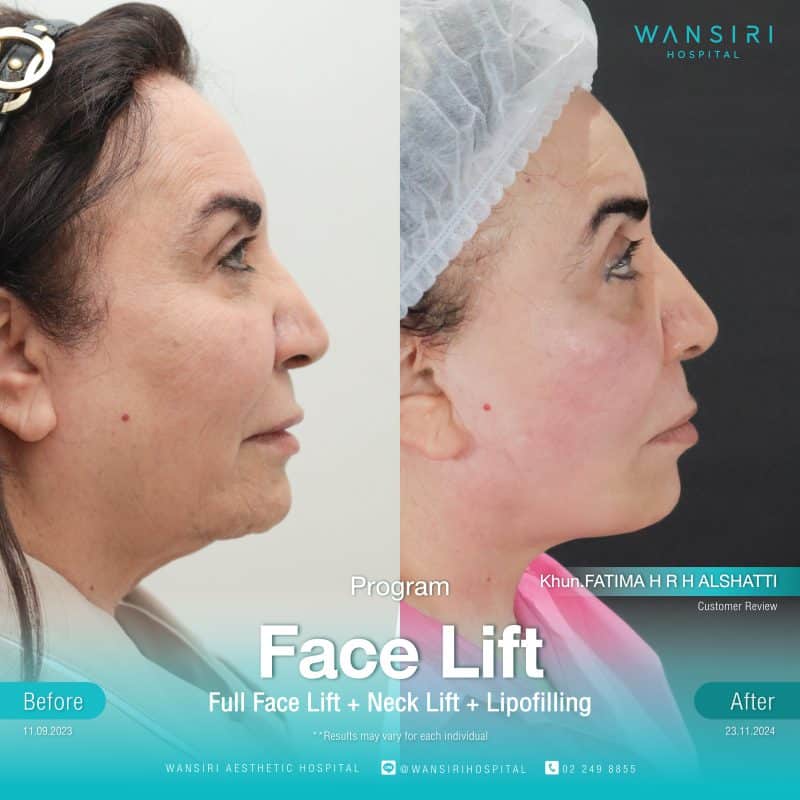
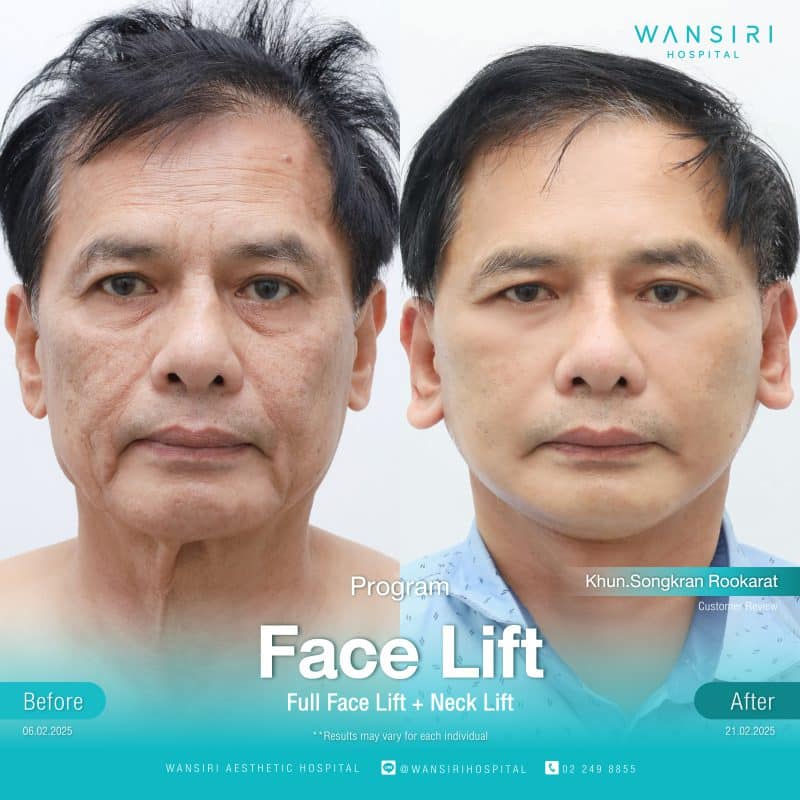
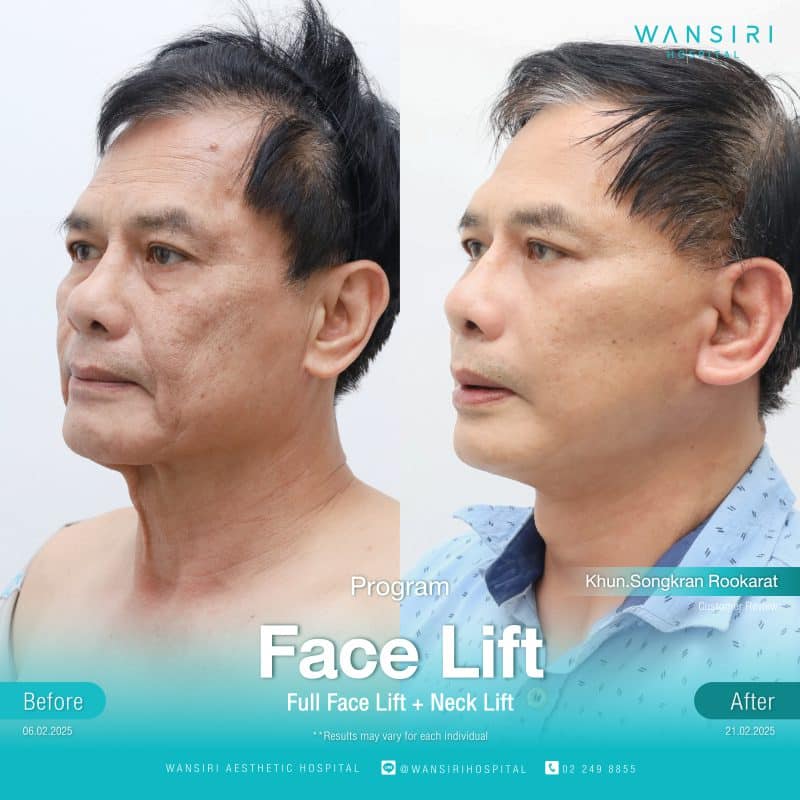
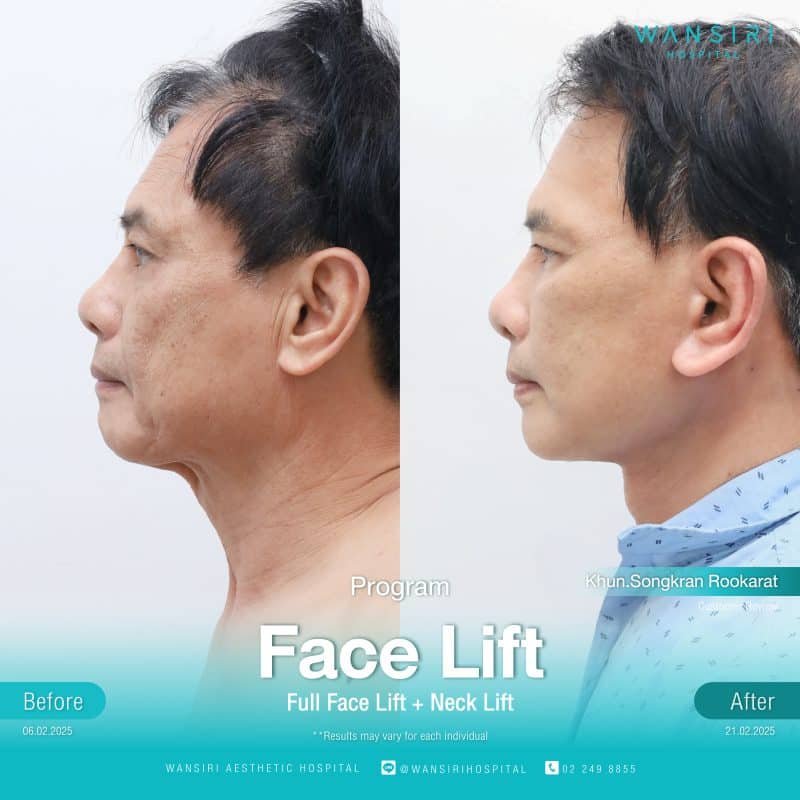

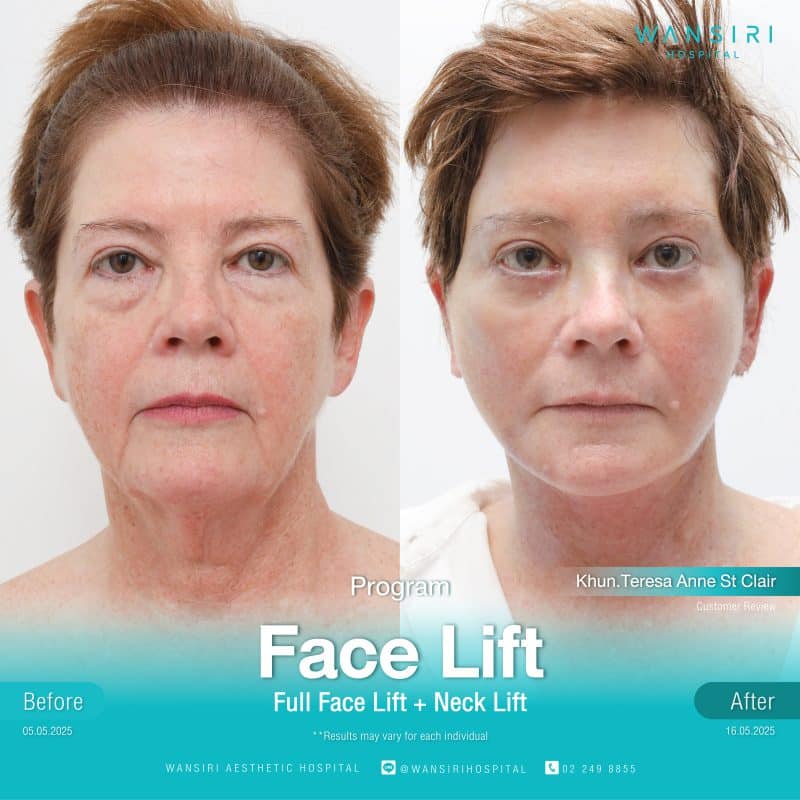
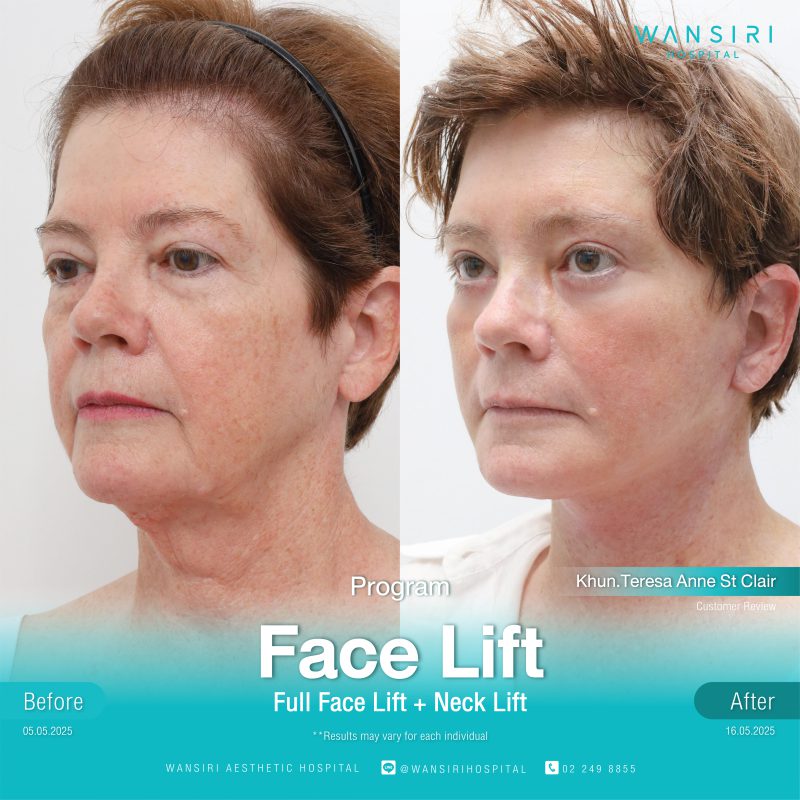
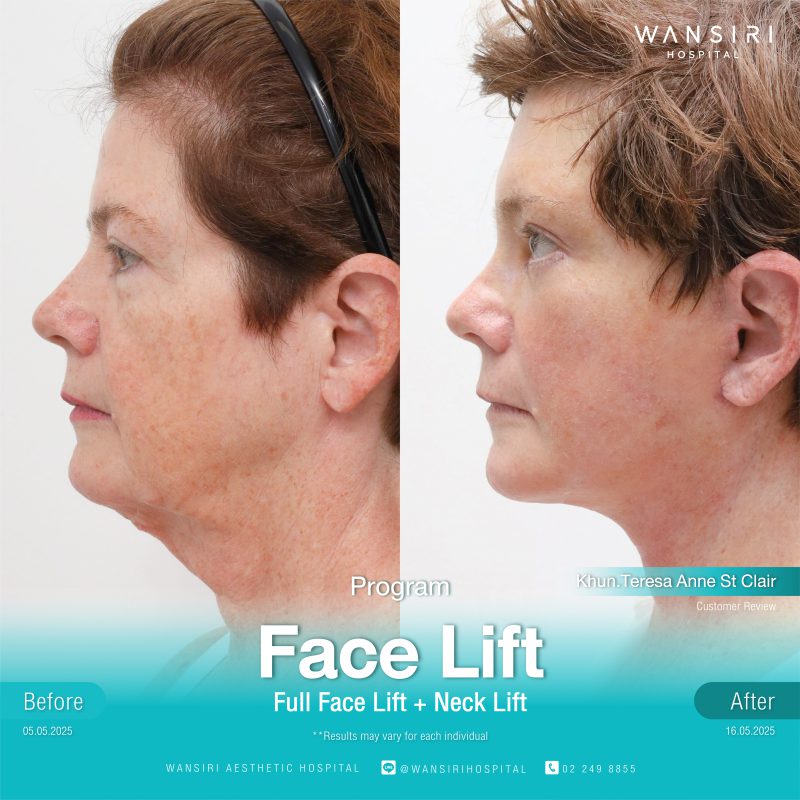
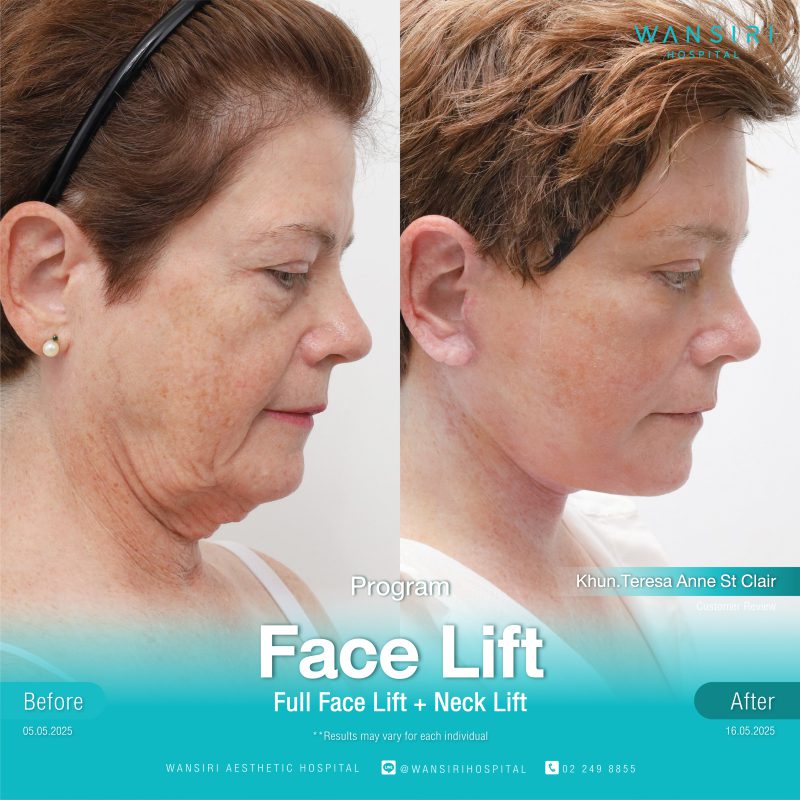
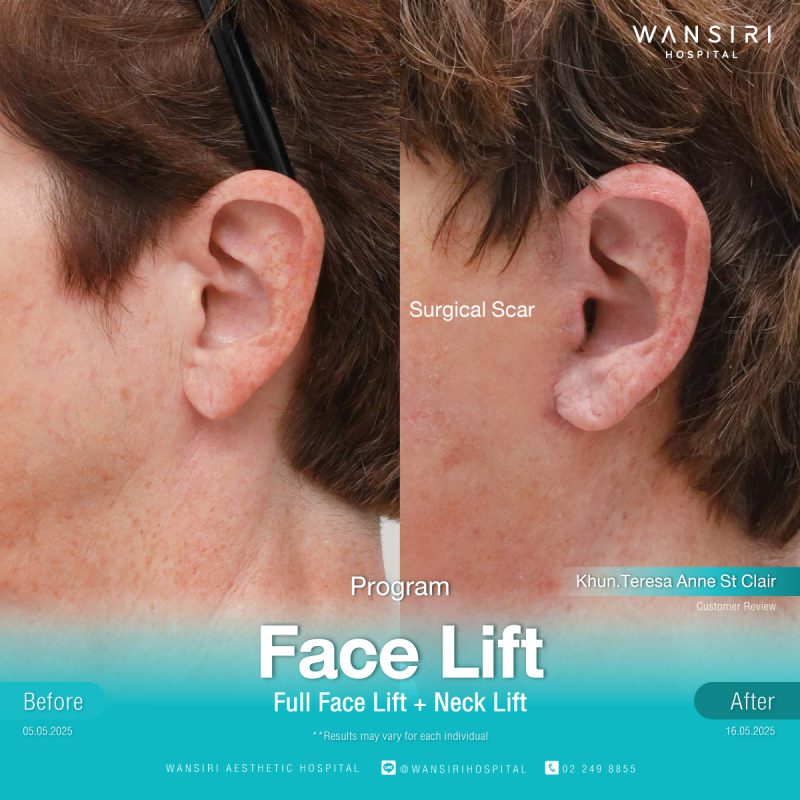
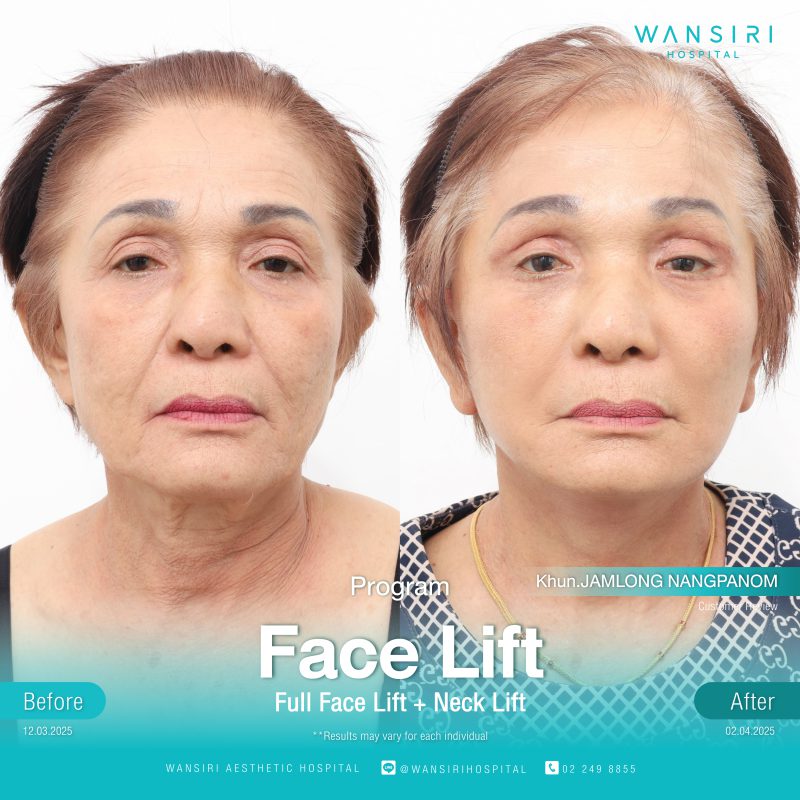

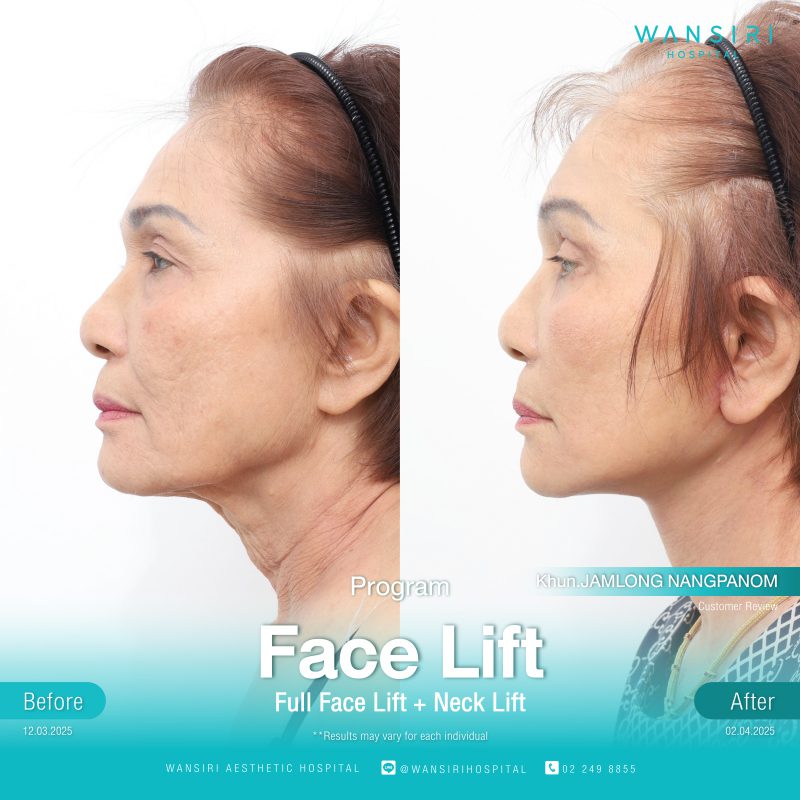
Why Choose Wansiri Hospital for a Facelift?
Facelift surgery is a highly intricate procedure due to the complex network of facial muscles, blood vessels, and nerves. Therefore, it is crucial to choose a medical facility that prioritizes safety and a highly experienced surgeon specializing in facelifts.
we focus on every detail to ensure the best possible outcome. Here’s why Wansiri Hospital is the best choice for your facelift procedure:
01
We have a team of devoted and attentive medical experts, certified by The Medical Council of Thailand
02
We have modern operating rooms, fitted with state-of-the-art medical equipment approved by international standards
03
We have medical anesthesiologists/ anesthetists that allow for you to have a restful, pain-free procedure
04
We have endoscopic technology, minimizing post-procedure scars and swelling
05
We have subcutaneous surgical methods that tightens your skin in the Sub-SMAS (Sub-Superficial Muscular Aponeurotic System) layer, ensuring long-lasting results
06
We are proud to present premium service standards to achieve the highest level of satisfaction
PROCEDURE
Operation Duration
3-4 Hours
Medication
Anesthetic
Overnight Stay
1-2 Nights
Recovery Period
1-2 weeks after the operation
Swelling
2-3 weeks
Follow-up Period
1-2 weeks (Stitch Removal)/ 1 month/ 3 months/ 6 months
Pre-Surgery Preparation
Postoperative Care
FAQS
How Long Does It Take for a Facelift to Settle? How Many Years Does It Last?
A common question many people ask is, how long does it take for a facelift to fully settle?
- In the first 7-14 days, swelling and bruising will be at their peak.
- Within 2-3 weeks, these symptoms will gradually fade.
- The face will start to settle into its new shape around 1-month post-surgery.
- Visible, refined results can typically be seen within 3-6 months after the procedure.
As for longevity, a facelift can last between 5-10 years, depending on factors such as skin condition, surgical technique, and post-operative care.
What is the Best Age for a Facelift?
A facelift can effectively address sagging skin and wrinkles and is typically recommended for individuals between the ages of 30 to 70. It is especially suitable for those experiencing early signs of aging, such as fine lines and skin laxity.
The incision scars are discreetly hidden along the hairline and behind the ears, ensuring natural-looking results.
Can You Wash and Dye Your Hair After a Facelift?
You can wash your hair 2 days after facelift surgery, but it must be done with care:
- Avoid scratching or rubbing the incision area.
- Use a cool air blow dryer to dry your hair gently.
- It is recommended to cover the incision with waterproof plastic to prevent water from getting into the wound.
For hair coloring, it is best to wait until the incision is fully healed before dyeing your hair. This helps prevent infections or allergic reactions caused by chemical exposure.
Can You Wash and Dye Your Hair After a Facelift?
You can wash your hair 2 days after facelift surgery, but it must be done with care:
- Avoid scratching or rubbing the incision area.
- Use a cool air blow dryer to dry your hair gently.
- It is recommended to cover the incision with waterproof plastic to prevent water from getting into the wound.
For hair coloring, it is best to wait until the incision is fully healed before dyeing your hair. This helps prevent infections or allergic reactions caused by chemical exposure.
Do You Need to Wear a Compression Bandage After a Facelift?
First 24 Hours:
After a facelift, it is recommended to wear a compression bandage continuously for the first 24 hours. This helps control swelling and reduce the risk of hematoma in the operated area.
First 7 Days:
For the first 7 days, wear the compression bandage for at least 3-4 hours per day. It not only reduces swelling but also helps set the facial contours and ensure the desired shape.
Rest Periods:
Do not wear the compression bandage all the time. Proper blood circulation in the operated area is essential for recovery. Avoid wearing it during sleep unless instructed by your doctor.
Personalized Instructions:
Your surgeon will give you individualized advice on how to wear the compression bandage and how to care for yourself after surgery. Following these guidelines will help you recover faster and minimize the risk of complications.


























